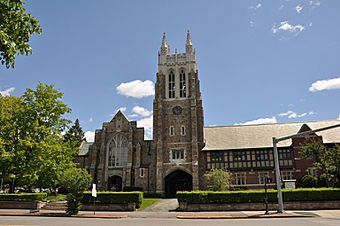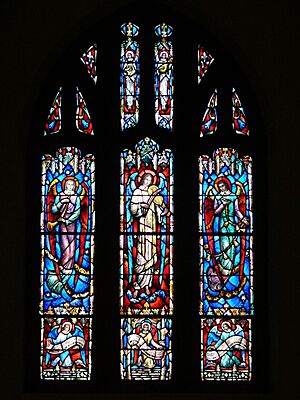First Unitarian Universalist Society in Newton facts for kids
|
First Unitarian Universalist Society in Newton
|
|
|
U.S. Historic district
Contributing property |
|
 |
|
| Location | 1326 Washington St., Newton, Massachusetts |
|---|---|
| Area | 1.3 acres (0.53 ha) |
| Built | 1906 |
| Architect | Cram, Goodhue & Ferguson |
| Architectural style | Late Gothic Revival, Tudor Revival, Elizabethan Revival |
| Part of | West Newton Village Center Historic District (ID90000017) |
| MPS | Newton MRA |
| NRHP reference No. | 86001802 |
Quick facts for kids Significant dates |
|
| Added to NRHP | September 4, 1986 |
| Designated CP | February 16, 1990 |
The First Unitarian Universalist Society in Newton is a historic church building. You can find it at 1326 Washington Street in West Newton. This area is part of Newton, Massachusetts.
The famous architect Ralph Adams Cram designed the church. The outdoor areas were designed by Frederick Law Olmsted Jr.. The first stone was placed in 1905, and the church was officially opened in 1906. It is one of the oldest buildings in the village.
Cool Architecture of the Church
The church building has a special look called Gothic Revival style. This means it looks like old European churches. It has strong walls with supports called buttresses. There is also a big square tower with decorative tops called crenellations and spires.
Other parts of the building include an office wing, a banquet hall, and a parish house. These sections form a closed courtyard. They are built in a style called Elizabethan architecture. This style often features a brick first floor with an upper level that looks like it has wooden beams on the outside.
A Bit of History
The Unitarian Society started in 1848. Their first building was built in 1860. It was also in the Gothic Revival style. Later, it was updated with a style called Stick style decoration. That first building stood where the West Newton Cinema is today.
The current church building was built on an important spot. It used to be the location of an early experimental normal school. A normal school was a place where people learned to become teachers. This school later moved to Framingham. Today, it is known as Framingham State University.
Inside the church, there is a beautiful stained glass window. This window honors two important people in Massachusetts education. They were Horace Mann and Cyrus Peirce. Both of them were also members of this church.
Important Recognition
The building was added to the National Register of Historic Places in 1986. It was listed under the name First Unitarian Church. This means it is recognized as a special historical place.
See also




